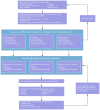Genetic causal relationship between immune diseases and migraine: a Mendelian randomization study
- PMID: 38650934
- PMCID: PMC11033421
- DOI: 10.3389/fimmu.2024.1376698
Genetic causal relationship between immune diseases and migraine: a Mendelian randomization study
Abstract
Background: Migraine has an increased prevalence in several immune disorders, but genetic cause-effect relationships remain unclear. Mendelian randomization (MR) was used in this study to explore whether immune diseases are causally associated with migraine and its subtypes.
Methods: We conducted a two-sample bidirectional multivariate Mendelian randomization study. Single-nucleotide polymorphisms (SNP) for six immune diseases, including rheumatoid arthritis (RA), systemic lupus erythematosus (SLE), type 1 diabetes mellitus (T1D), allergic rhinitis (AR), asthma and psoriasis, were used as genetic instrumental variables. Summary statistics for migraine were obtained from 3 databases: the International Headache Genetics Consortium (IHGC), UK Biobank, and FinnGen study. MR analyses were performed per outcome database for each exposure and subsequently meta-analyzed. Reverse MR analysis was performed to determine whether migraine were risk factors for immune diseases. In addition, we conducted a genetic correlation to identify shared genetic variants for these two associations.
Results: No significant causal relationship was found between immune diseases and migraine and its subtypes. These results were robust with a series of sensitivity analyses. Using the linkage disequilibrium score regression method (LDSC), we detected no genetic correlation between migraine and immune diseases.
Conclusion: The evidence from our study does not support a causal relationship between immune diseases and migraine. The mechanisms underlying the frequent comorbidity of migraine and several immune diseases need to be further elucidated.
Keywords: Mendelian randomization; causal association; genetic correlation; immune diseases; migraine.
Copyright © 2024 Li, Duan, International Headache Genetics Consortium (IHGC), Zheng, Zhu, Qu, Liu and Liu.
Conflict of interest statement
The authors declare that the research was conducted in the absence of any commercial or financial relationships that could be construed as a potential conflict of interest.
Figures





References
Publication types
MeSH terms
LinkOut - more resources
Full Text Sources
Medical
Research Materials

